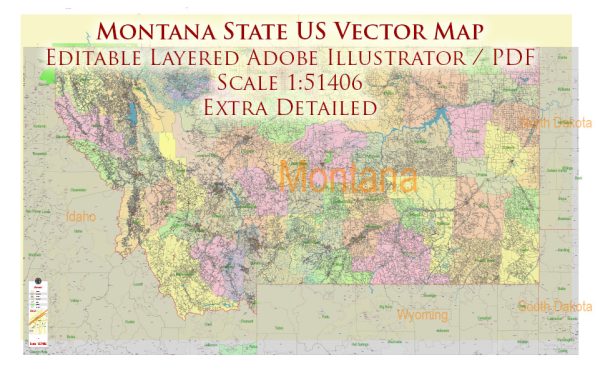Montana is a state in the western United States known for its diverse and stunning geological features. The state’s geology is characterized by a wide range of rock formations, mountain ranges, and natural landmarks, making it a fascinating place for geologists and outdoor enthusiasts. Here’s a brief description of Montana State’s geology:
- Rocky Mountains: Montana is home to a significant portion of the Rocky Mountains, which run through the western part of the state. This mountain range includes iconic peaks like the Beartooth Mountains, Absaroka Range, and Bitterroot Range, offering breathtaking scenery and diverse geologic features.
- Glacial Activity: Montana’s landscape bears evidence of past glacial activity, with U-shaped valleys, cirques, and moraines found in various regions. The state’s rugged topography and numerous alpine lakes are a testament to the power of glaciation during the last ice age.
- Yellowstone Supervolcano: The northwestern corner of Montana is part of the Yellowstone hotspot, known for the Yellowstone Caldera, a supervolcano. This massive volcanic system is responsible for the geothermal wonders of Yellowstone National Park, including geysers, hot springs, and fumaroles.
- Fossil Deposits: Montana is renowned for its rich fossil deposits, particularly in the eastern part of the state. The Hell Creek Formation, for example, has yielded numerous dinosaur fossils, making it a significant area for paleontological research.
- Sedimentary Basins: The state contains several sedimentary basins, including the Williston Basin and the Powder River Basin. These basins have played a crucial role in the state’s economic development, particularly in the extraction of oil and natural gas.
- Mineral Resources: Montana has a long history of mining and is known for its mineral resources. The state has deposits of gold, silver, copper, and other valuable minerals. The Butte-Anaconda area was once one of the largest copper mining centers in the world.
- Glacial Lakes: Montana is home to numerous glacial lakes, including Flathead Lake, which is one of the largest freshwater lakes in the United States by surface area. These lakes are often surrounded by picturesque landscapes and mountainous terrain.
- Geological Diversity: Montana’s geology is diverse, with different rock types, including sedimentary, igneous, and metamorphic rocks. Geologists can study a wide range of geologic processes and landforms in the state, making it a valuable area for research.
Overall, Montana’s geology is a testament to the state’s geological history, characterized by a wide range of natural wonders and a rich geological heritage. It offers a wealth of opportunities for scientific exploration and outdoor adventures for those interested in the Earth’s fascinating processes.


 Author: Kirill Shrayber, Ph.D.
Author: Kirill Shrayber, Ph.D.